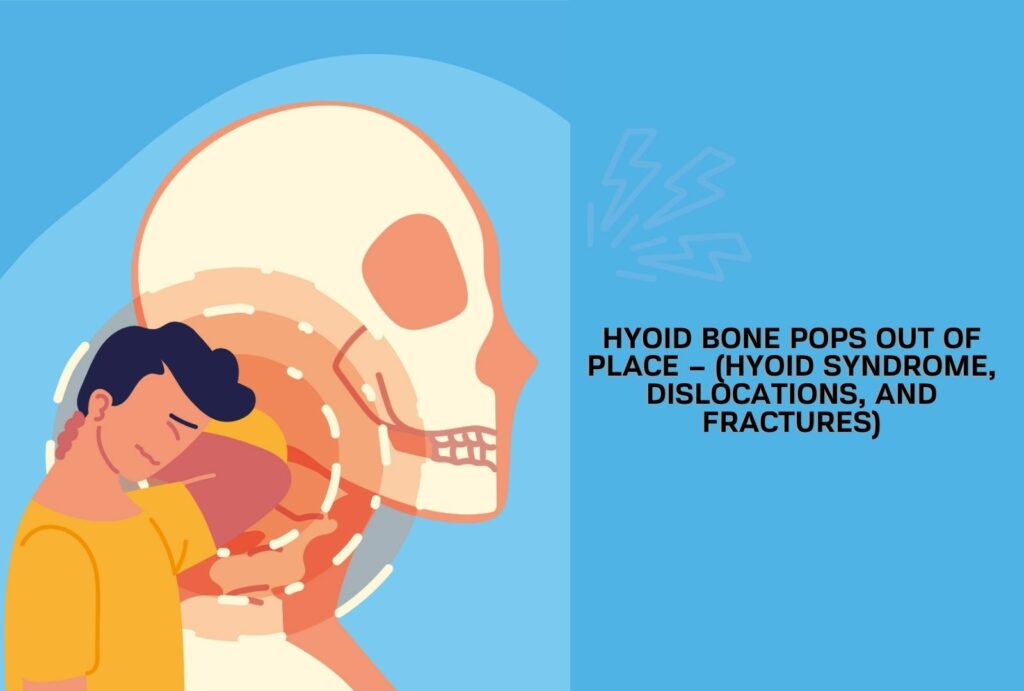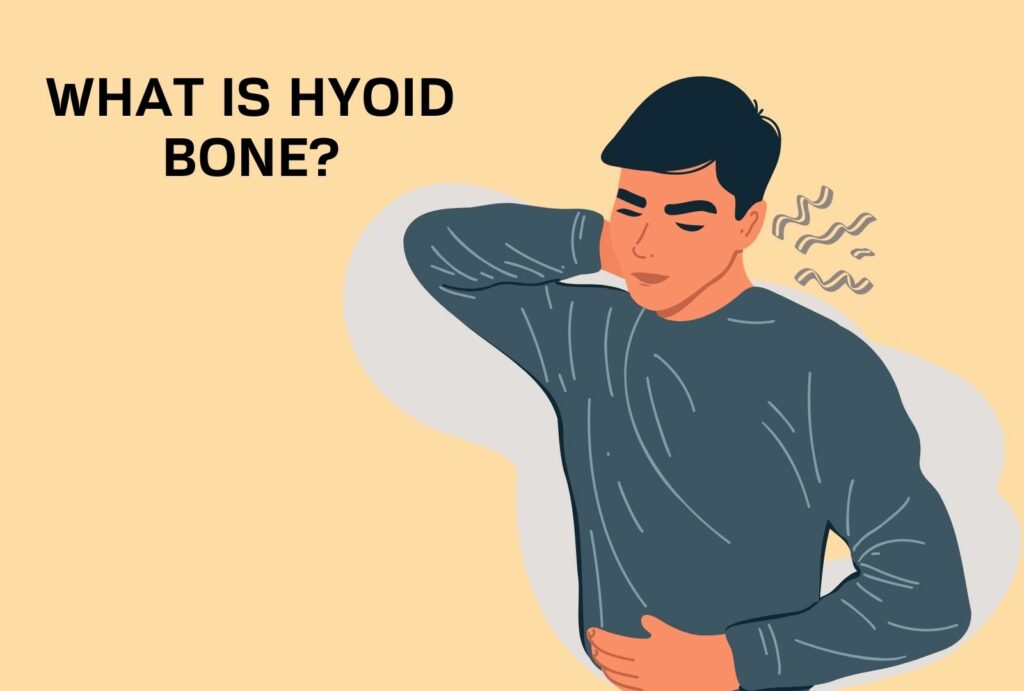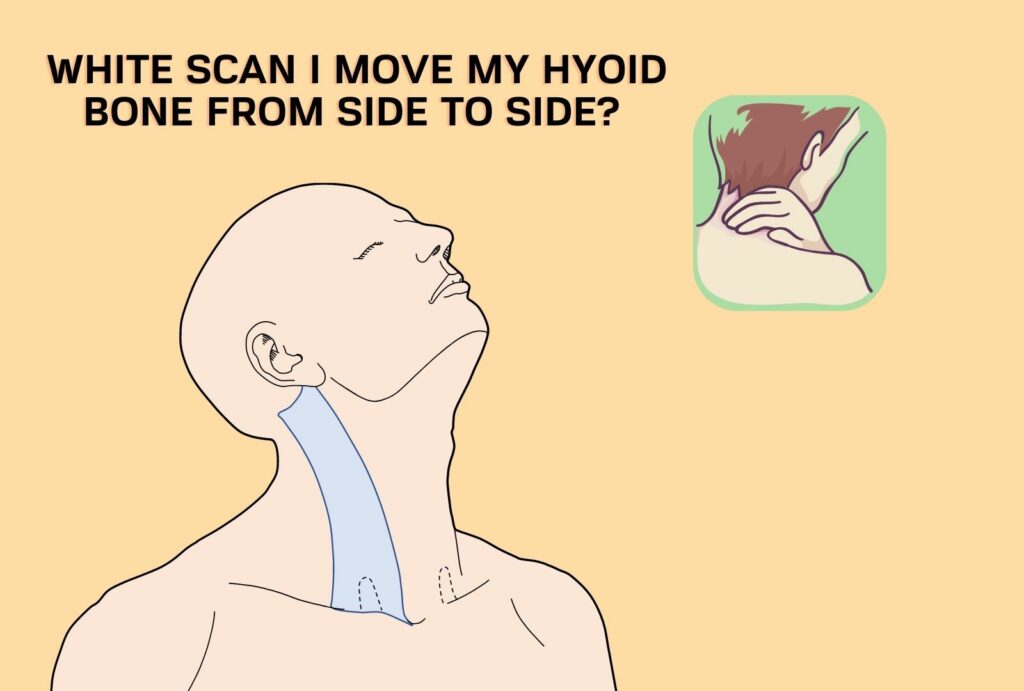
The hyoid bone is a small, horseshoe-shaped bone located in the neck region, just above the thyroid cartilage. Although it is a small bone, it has a significant role in supporting the tongue and helping with swallowing and breathing. In some cases, the hyoid bone can pop out of place, causing discomfort and difficulty in swallowing. This condition is known as hyoid bone pops out of place or hyoid syndrome.
Hyoid syndrome can be caused by a variety of factors, including trauma, such as a car accident or sports injury, repetitive strain, poor posture, or degenerative changes in the spine. When the hyoid bone pops out of place, it can cause discomfort, pain, and difficulty swallowing. In severe cases, it may even interfere with breathing.
Dislocations and fractures are two other common conditions that can affect the hyoid bone. Dislocations occur when the bone is pushed out of its normal position, while fractures occur when the bone is broken. Both of these conditions can cause pain, swelling, and difficulty swallowing, and require medical attention.
Treatment for hyoid syndrome typically involves a combination of physical therapy, stretching, and strengthening exercises to help realign the bone and reduce discomfort. In severe cases, surgery may be necessary to reposition the hyoid bone and stabilize it.
Dislocations and fractures of the hyoid bone are usually treated with immobilization, rest, and pain management. In some cases, surgery may be required to realign the bone and stabilize it. Recovery time for these conditions varies depending on the severity of the injury and the treatment plan.
In conclusion, the hyoid bone plays an essential role in supporting the tongue and helping with swallowing and breathing. When the hyoid bone pops out of place, it can cause discomfort and difficulty in swallowing, which is known as hyoid syndrome. Dislocations and fractures are other conditions that can affect the hyoid bone and require medical attention. If you are experiencing any symptoms related to the hyoid bone, it is essential to seek medical attention to determine the underlying cause and appropriate treatment plan.
What is hyoid bone?

The hyoid bone is a small, U-shaped bone located in the neck between the chin and the thyroid cartilage. It is the only bone in the body that does not articulate with any other bone. Instead, it is suspended in place by muscles and ligaments. The hyoid bone serves as an attachment point for the tongue, larynx, and pharynx muscles, and plays a crucial role in speech and swallowing. When the hyoid bone pops out of place, it can cause discomfort and even lead to more severe health conditions.
The hyoid bone is an essential component of the body’s anatomy and plays a crucial role in various functions such as speech, swallowing, and breathing. The bone’s unique structure and location make it vulnerable to dislocation, fracture, and other injuries. Hyoid bone popping out of place is a relatively uncommon occurrence, but it can cause significant discomfort, especially during swallowing or talking. Some people may experience hyoid syndrome, which is a condition characterized by a recurrent popping or snapping sensation in the hyoid bone.
Hyoid bone dislocations and fractures can occur due to various reasons such as trauma, straining the neck, or a forceful impact to the neck. In some cases, underlying medical conditions such as osteoporosis or cancer can weaken the hyoid bone and make it more susceptible to injury. The symptoms of a dislocated or fractured hyoid bone may include pain or tenderness in the neck, difficulty swallowing or talking, a popping sensation in the throat, or a visible lump in the neck.
The diagnosis of a hyoid bone dislocation or fracture typically involves a physical examination, imaging tests such as X-rays or CT scans, and other diagnostic procedures as required. Treatment options depend on the severity and underlying cause of the injury. Mild cases may resolve on their own, while more severe cases may require immobilization or surgery. It is essential to seek medical attention if you experience any symptoms related to a hyoid bone injury, as untreated cases can lead to complications such as airway obstruction, infection, or chronic pain.
In conclusion, the hyoid bone is a small but essential bone in the body that plays a crucial role in speech, swallowing, and breathing. When the hyoid bone pops out of place, it can cause discomfort and even lead to more severe health conditions. Hyoid bone dislocations and fractures can occur due to various reasons, including trauma or underlying medical conditions. The diagnosis and treatment of a hyoid bone injury depend on the severity and underlying cause of the injury. If you experience any symptoms related to a hyoid bone injury, seek medical attention immediately to prevent further complications.
Can I move my hyoid bone from side to side?

The hyoid bone is a U-shaped bone located in the neck, just below the chin. It is unique in that it is the only bone in the human body that is not connected to any other bones. The hyoid bone serves as an attachment site for several muscles involved in swallowing, speaking, and breathing. While it is possible to move the hyoid bone from side to side, doing so should not cause it to pop out of place. If you experience any pain or discomfort when moving your hyoid bone, it is important to seek medical attention to rule out any underlying issues.
Hyoid syndrome is a condition where the hyoid bone is displaced or subluxed from its normal position. This can cause a variety of symptoms, including pain in the neck or throat, difficulty swallowing, and a popping or clicking sensation when moving the neck. In some cases, the hyoid bone may even dislocate or fracture, which can be a more serious issue requiring medical attention.
Hyoid syndrome can be caused by a variety of factors, including trauma to the neck or throat, overuse of the muscles attached to the hyoid bone, or degeneration of the surrounding tissues due to age or disease. Treatment for hyoid syndrome typically involves rest, anti-inflammatory medication, and physical therapy to strengthen the muscles involved in supporting the hyoid bone. In severe cases, surgical intervention may be necessary.
Hyoid bone dislocations and fractures are rare but can occur due to trauma to the neck or throat, such as from a fall or a car accident. Symptoms of a dislocated or fractured hyoid bone may include severe pain in the neck or throat, difficulty swallowing or speaking, and swelling or bruising in the affected area. These injuries are considered medical emergencies and require immediate attention from a healthcare professional.
In conclusion, while it is possible to move the hyoid bone from side to side, doing so should not cause it to pop out of place. Hyoid syndrome, dislocations, and fractures can all cause pain and discomfort in the neck and throat, and require medical attention. If you experience any symptoms related to your hyoid bone, it is important to seek the advice of a healthcare professional.
Can you dislocate your hyoid bone?
The hyoid bone is an important but delicate bone that can be susceptible to dislocation. A hyoid bone dislocation occurs when the bone is forced out of its normal position. The hyoid bone is located in the neck and supports the tongue and other structures in the throat. It is surrounded by muscles and ligaments that help to keep it in place, but certain traumas or accidents can cause it to become dislocated.
A dislocated hyoid bone can be a painful and concerning condition. It can cause difficulty breathing, swallowing, and speaking, as well as discomfort and pain in the neck area. In some cases, the dislocation may be visible or palpable as a lump in the neck. However, it is important to note that hyoid bone dislocations are rare and typically only occur in cases of severe trauma or injury to the neck.
If you suspect that you have a dislocated hyoid bone, it is important to seek medical attention immediately. A doctor or healthcare professional can perform a physical examination and may order imaging tests such as X-rays or CT scans to confirm the diagnosis. Treatment for a dislocated hyoid bone typically involves reducing the dislocation and immobilizing the area with a neck brace or other device to allow the bone to heal.
In addition to dislocation, the hyoid bone can also be at risk for fracture. This is typically seen in cases of blunt force trauma to the neck, such as in a car accident or fall. Fractures of the hyoid bone can also cause pain and difficulty breathing or swallowing, and may require medical attention.
Overall, while dislocation and fracture of the hyoid bone are rare, they can be serious conditions that require medical attention. It is important to seek prompt medical care if you suspect you have injured your hyoid bone, as early treatment can help to prevent further complications and promote healing.
What is a hyoid bone syndrome?
Hyoid bone syndrome is a condition in which the hyoid bone, a small, U-shaped bone located in the neck, pops out of place or becomes dislocated. This can cause discomfort, pain, and difficulty swallowing or speaking. The hyoid bone plays an important role in the function of the muscles of the mouth and throat, and its movement can be affected by factors such as trauma, repetitive strain, or underlying medical conditions.
Pain or discomfort
The symptoms of hyoid bone syndrome can include pain or discomfort in the neck, jaw, or throat, as well as difficulty swallowing or speaking. The sensation of a lump or tightness in the throat is also common. Symptoms may be triggered by activities such as talking, singing, or chewing, or may be present at rest. In some cases, the hyoid bone may be visible or palpable as a small bump in the neck.
Diagnosis of hyoid bone syndrome may involve imaging studies such as X-rays, CT scans, or MRI, as well as physical examination and evaluation of medical history and symptoms. Treatment may involve conservative measures such as rest, pain relief, and physical therapy, or may require surgical intervention in more severe cases.
Misdiagnosed or overlooked
Hyoid bone syndrome is not a common condition and is often misdiagnosed or overlooked. However, it can cause significant discomfort and impairment of daily function, and early recognition and treatment can lead to better outcomes. If you are experiencing symptoms of hyoid bone syndrome, it is important to seek medical evaluation and care.
Prevention of hyoid bone syndrome may involve avoiding activities that strain the muscles of the neck and throat, such as heavy lifting or repetitive motions, as well as maintaining good posture and practicing proper technique in activities such as singing or speaking. Additionally, treating underlying medical conditions such as acid reflux or allergies may help prevent symptoms of hyoid bone syndrome.
In summary, hyoid bone syndrome is a condition in which the hyoid bone becomes dislocated or pops out of place, causing pain, discomfort, and difficulty swallowing or speaking. Diagnosis may involve imaging studies and physical examination, and treatment may involve conservative measures or surgical intervention. Prevention involves avoiding activities that strain the muscles of the neck and throat and treating underlying medical conditions. If you are experiencing symptoms of hyoid bone syndrome, it is important to seek medical evaluation and care.
FAQs
- Can a hyoid bone fracture be life-threatening?
In rare cases, a hyoid bone fracture can be life-threatening if it occurs in conjunction with other injuries to the neck. This is because the hyoid bone is close to the carotid artery and the windpipe, so a fracture can cause significant damage to these vital structures.
- How is hyoid bone dislocation treated?
Treatment for hyoid bone dislocation involves reducing the displacement of the bone back into its original position. This can be done through manual manipulation, with the patient under local anesthesia or sedation. In some cases, surgery may be necessary to repair any associated soft tissue injuries.
- Can you prevent hyoid bone syndrome?
There is no surefire way to prevent hyoid bone syndrome, but maintaining good posture and avoiding repetitive neck movements may help reduce the risk of developing this condition. Additionally, treating underlying medical conditions that can lead to muscle spasms or neck pain, such as acid reflux or TMJ disorder, can help prevent hyoid bone syndrome.
- What kind of doctor should I see if I have symptoms of hyoid bone syndrome?
If you have symptoms of hyoid bone syndrome, such as neck pain or difficulty swallowing, you should make an appointment with an ear, nose, and throat (ENT) doctor or a head and neck surgeon. They can evaluate your symptoms and perform any necessary tests to determine if your hyoid bone is out of place or if you have another underlying condition.
- Is hyoid bone syndrome common?
Hyoid bone syndrome is a relatively rare condition, but it can occur in anyone. It is more common in women and people over the age of 40, and it often occurs in people who have underlying medical conditions that affect the neck muscles or nerves, such as acid reflux or TMJ disorder.
Conclusion
In conclusion, the hyoid bone plays an essential role in supporting the structure of the neck and throat. Dislocation or popping out of place of the hyoid bone can occur due to trauma, injury, or underlying medical conditions like hyoid bone syndrome. Symptoms of hyoid bone dislocation or syndrome may include pain, difficulty swallowing, and a popping or clicking sound in the throat area. While some cases may require medical intervention, others may improve with self-care measures like applying heat or ice, taking over-the-counter pain medications, or practicing exercises to strengthen the neck and throat muscles. It is always best to seek medical advice if you suspect a hyoid bone injury or disorder to prevent any potential complications.
It is important to note that the information provided here is for educational purposes only and is not intended to replace medical advice. If you have any concerns or questions about your hyoid bone or related symptoms, consult a qualified healthcare professional.